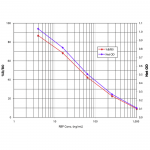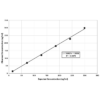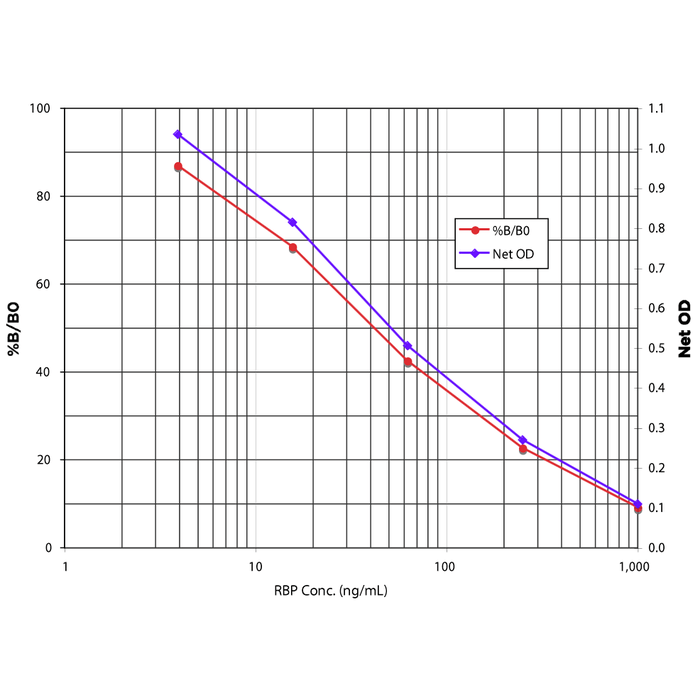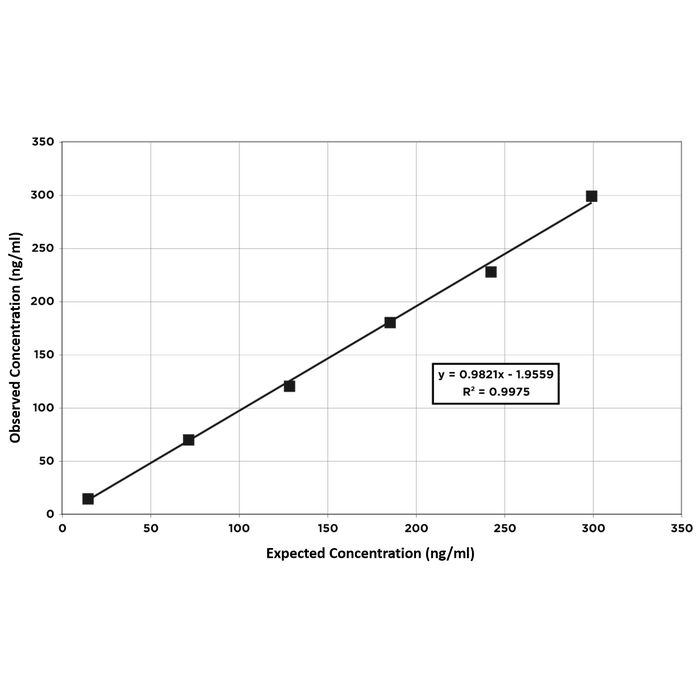| Product Name | Retinol Binding Protein Urinary EIA Kit (Discontinued) |
| Description |
Colorimetric measurement of RBP levels in urine |
| Species Reactivity | Dog, Human, Monkey, Rat |
| Platform | Microplate |
| Sample Types | Urine |
| Detection Method | Colorimetric Assay |
| Assay Type | Sandwich EIA (Enzyme Immunoassay) |
| Utility | EIA kit used to measure RBP levels in urine samples. |
| Sensitivity | 2.90 ng/ml |
| Assay Range | 3.906 - 1000 ng/ml |
| Precision | Intra Assay Precision: Four human urine samples were diluted 1:2 with Assay Buffer and run in replicates of 8 in an assay. The mean and precision of the calculated RBP concentrations were: Sample 1- 14.8 ng/mL, 4.5% CV Sample 2- 28.0 ng/mL, 7.5% CV Sample 3- 53.5 ng/mL, 7.3% CV Sample 4- 323.7 ng/mL, 2.1% CV Inter Assay Precision: Four human urine samples were diluted 1:2 with Assay Buffer and run in duplicates in twenty-one assays run over multiple days by three operators. The mean and precision of the calculated RBP concentrations were: Sample 1- 14.4 ng/mL, 9.1% CV Sample 2- 28.0 ng/mL, 9.2% CV Sample 3- 50.8 ng/mL, 8.1% CV Sample 4- 309.2 ng/mL, 14.0% CV |
| Incubation Time | 90 Minutes |
| Number of Samples | 41 samples in duplicate |
| Other Resources | Kit Booklet , MSDS |
| Field of Use | Not for use in humans. Not for use in diagnostics or therapeutics. For in vitro research use only. |
Properties
| Storage Temperature | 4ºC | ||||||||||||||||||||||||||||||
| Shipping Temperature | Blue Ice | ||||||||||||||||||||||||||||||
| Product Type | EIA Kits | ||||||||||||||||||||||||||||||
| Assay Overview | The Retinol Binding Protein Urinary EIA Kit is designed to quantitatively measure RBP present in urine samples. A RBP standard is provided to generate a standard curve for the assay and all samples should be read off the standard curve. Standards or diluted samples are pipetted into a clear microtiter plate coated with an antibody to capture rabbit antibodies. A RBP-peroxidase conjugate is added to the standards and samples in the wells. The binding reaction is initiated by the addition of the RBP polyclonal antibody to each well. After an hour incubation the plate is washed and substrate is added. The substrate reacts with the bound RBP-peroxidase conjugate. After a short incubation, the reaction is stopped and the intensity of the generated color is detected in a microtiter plate reader capable of measuring 450 nm wavelength. The concentration of the RBP in the sample is calculated, after making a suitable correction for the dilution of the sample, using software available with most plate readers. | ||||||||||||||||||||||||||||||
| Kit Overview |
|
||||||||||||||||||||||||||||||
| Cite This Product | Retinol Binding Protein Urinary EIA Kit (StressMarq Biosciences Inc., Victoria BC CANADA, Catalog # SKT-218) |
Biological Description
| Alternative Names | Cellular retinol binding protein EIA Kit, CRBP EIA Kit, CRBP EIA Kit, CRBP1 EIA Kit, CRBP2 EIA Kit, RBP1 EIA Kit, RBP2 EIA Kit, RBP4 EIA Kit, RBPC EIA Kit, Retinol binding protein 1 EIA Kit, Retinol binding protein 2 EIA Kit, Retinol binding protein 4 EIA Kit |
| Research Areas | Cardiovascular System, Cell Signaling |
| Scientific Background |
Retinol binding protein (RBP) is from a family of structurally related proteins that bind small hydrophobic molecules such as bile pigments, steroids, odorants, etc (1). RBP is a 21 kDa highly conserved, single-chain glycoprotein, consisting of 182 amino acids with 3 disulfide bonds, that has a hydrophobic pocket which binds retinol (vitamin A). RBP binds retinol in a 1:1 stoichiometry, which serves to not only solubilize retinol but also protect it from oxidation. When in serum, the majority of RBP bound with retinol is reversibly complexed with transthyretin (prealbumin) (2,3). This complex then transports retinol to specific receptors of various tissues in the body. Vitamin A status is reflected by serum concentration as it is hemostatically controlled and does not fall until stores are dramatically reduced (4,5). RBP has also been shown to be a useful marker for renal function (6) as it is totally filtered by the glomeruli and reabsorbed by proximal tubules (7). This has made urinary RBP (uRBP) a tool to study renal function in heart (8) or kidney (9) transplant recipients, type 1 and 2 diabetics (10), and in people exposed to uranium from mining operations (11). Measurement of uRBP levels has also been useful in detection and characterization of diseases including hypertension (12) and certain cancers (13,14). |
| References |
1. Blaner WS. Endocr Rev. 1989 Aug;10(3):308–16. 2. Wolf G. Physiol. Rev. 1984 Jul;64(3):873-937. 3. Petersen PA. J. Biol. Chem. 1971, 246:34-43. 4. Goodman DS, Blaner WS. in The Retinoids, eds. Sporn MB, Roberts AB, Goodman DS, (Orlando: Academic Press, 1984) vol.2, 1-39. 5. Olson, JA. Modern Nutrition in Health and Disease, eds. Shils ME, Olson JA, Shike M, (Philadelphia: Lea & Febiger, 1994) 8th ed. 287–307. 6. Peterson PA, and Berggård I. J. Biol. Chem. 1971 246:25-33. 7. Bernard AM, and Lauwerys RR. Clin. Chem. 1981 27:1781-2. 8. Camara NO, Matos AC, Rodrigues DA et al. The Lancet 2001 357: 856-857. 9. Hosaka B, Park SI, Felipe CR, Garcia RG, Machado PG, Pereira AB, Tedesco-Silva H and Medina-Pestana JO. Transplant Proc. 2003 35:1341-1343. 10. Abahusain MA, Wright J, Dickerson JWT and de Vol EB. Am J Clin Nutr. 2004;79:218-25. 11. Wyatt SA, Reitz LV, Croley TR, Hawkins D, Barrett E, McKeown A, Powell N, West A, Hamner T and Royster MO. J Exp Sci Environ Epidem. 2008 18:59-75. 12. Bang LE, Holm J and Svendsen TL. Am. J. Hypertens 1996 9:1024-1028. 13. Moise AR, Noy N, Palczewski K, Blaner WS. Biochemistry 2007 9:1024-1028. 14. Gavrilov V, Yermiahu T, Gorodischer R. Kidney Int. 2006 Jan;69(1):173-7. |





Reviews
There are no reviews yet.